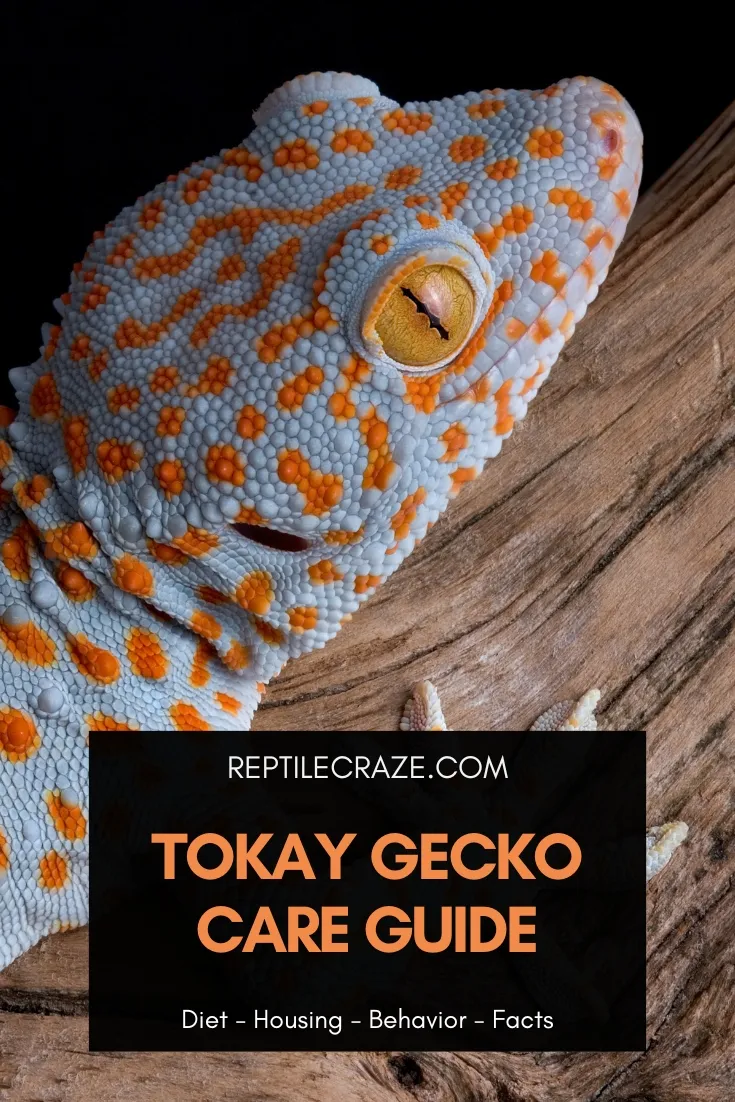
Tokay geckos are one of the largest and most beautiful gecko species; however, they are known for being highly aggressive and having a very strong bite.
Nevertheless, they can be good pets for people that have some previous experience handling reptiles because their care needs are pretty straightforward once their enclosure is all setup.
Here is a care sheet that can guide you to ensure your tokay gecko is as healthy and comfortable as possible:
Table of Contents
Tokay Gecko Facts
| Common name | Tokay gecko |
| Scientific name | Gekko gecko |
| Natural habitat | Asia and some Pacific Islands |
| Adult size | Females: 8 in to 12 in (20 cm to 30 cm)Males: 13 in to 16 in (35 cm to 40 cm) |
| Enclosure size | Minimum |
| Diet | Mostly insects like crickets, locusts, mealworms, cockroaches, grasshoppers, moths, etc. |
| Lifespan | 8 to 15 years |
| Experience level | Intermediate |
Where Do Tokay Geckos Live?
Tokay geckos are arboreal reptiles. They live in tropical rainforests and rock crevices across southeast and east Asia, as well as some Pacific Islands.
Tokay Gecko Appearance, Colors And Morphs

Tokay geckos are one of the largest gecko species, they have a thick cylindrical body and well-defined limbs.
They have a bluish or grayish color and their body is covered in spots that range from light yellow to bright red. Males are more brightly colored than females.
Tokay geckos are very good at camouflaging themselves as they are able to lighten or darken their skin color in order to blend in with their surroundings and they also have skin folds that prevent them from casting a shadow when resting on a tree.
One of the most outstanding abilities tokay geckos have is that they can “stick” to surfaces thanks to their impressive grip force, which can support about 250 pounds.
This is possible because their pads are covered with fine filaments called setae that allow them to adhere to nearly every surface.
These reptiles can attach and detach their pads in milliseconds which allows them to run very fast and hold onto smooth vertical and inverted surfaces without falling.
When under stressful conditions, tokay geckos can detach their tails as a defensive mechanism. This is known as autotomy.
The detached tail will keep twitching thanks to ongoing muscular contractions, thus distracting the predator so the gecko can escape.
How Big Do Tokay Geckos Get?
Males can measure around 13 in to 16 in (35 cm to 40 cm). Females are smaller, measuring from 8 in to 12 in (20 cm to 30 cm).
Tokay geckos can weigh around 120 gr to 250 gr.
Tokay Gecko Lifespan
In captivity, tokay geckos can live from 8 to 15 years, with an average of 10 years.
How To Care For Tokay Geckos?

Tokay Geckos Tank Setup
You need to make sure to provide an enclosure that is big enough for your pet to comfortably live in. The
- For 1 tokay gecko: 32 in x 12 in x 40 in (80 cm × 30 cm × 100 cm)
- For 2 tokay geckos: 32 in x 24 in x 40 in (80 cm × 60 cm × 100 cm)
A glass
A mesh enclosure may also work as long as you can ensure stable temperature and humidity levels. Make sure to use an appropriate mesh size and material that doesn’t allow for your pet to escape or injure themselves.
Do not use a wooden enclosure as fungus can grow on it and decay can happen very fast due to the high humidity levels your pet needs.
In any case, always place a secure lid on your
Lighting And Temperature
Since tokay geckos are nocturnal species that live in warmer tropical climes, they require higher ambient temperatures. This can be achieved by using higher-output bulbs and providing a basking spot during the day.
At night, you can use a nighttime reptile heat bulb or a ceramic heat element to keep the ambient temperature at an appropriate range.
You should aim to keep the ambient temperature at a range of 80°F to 90°F (27°C to 32°C) during the day, and from 70°F to 80°F (21°C to 27°C) during the night.
Do Tokay Geckos Need UVB?
As we mentioned before, tokay geckos are nocturnal species. However, this doesn’t mean they don’t need ultraviolet B (UVB) radiation.
In the wild, tockay geckos are still exposed to low levels of UVB light at dawn and dusk; therefore, it is recommended you provide your pet with low-intensity UVB light for 10 to 12 hours during the day, allowing them to have plenty of shadow and hiding spots.
You can also provide higher-intensity UVB light for just one hour at dusk and dawn, as long as you also expose your pet to visible light during the rest of the day.
Be careful not to overexpose your tockay gecko to more UVB radiation than needed, as this can lead to some skin problems.
Substrate
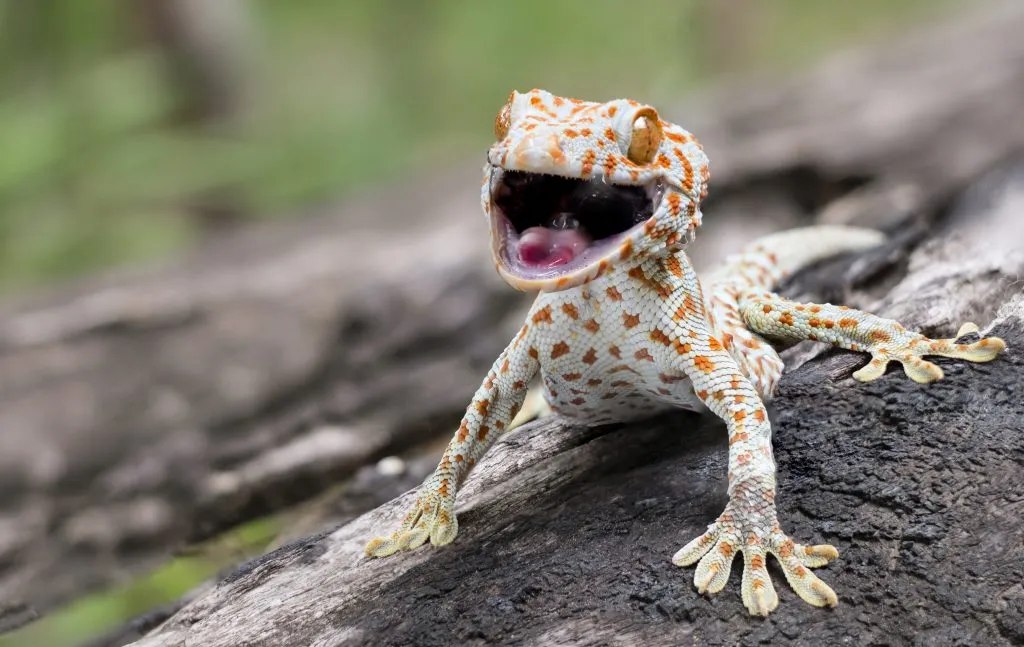
There are several types of substrates that can be used in a tokay gecko’s enclosure, such as:
- Fine reptile sand, like this one mixed with soil
- Coconut fiber, like Zoo Med Eco Earth Loose Coconut Fiber
- Moss, like Exo Terra Forest Plume Moss
- Soil
- Orchid bark
- Children’s play sand
Tokay geckos are arboreal reptiles that tend to feed on higher levels, which means their risk of accidentally eating substrate when feeding themselves is low.
However, some substrates like coarse sand and calcium based-sand can cause impaction if digested, so we do not recommend using them regularly.
Humidity
Since tokay geckos are native to tropical climates, they need high humidity levels ranging from 60 to 80%.
You can make sure to maintain appropriate humidity levels in the enclosure by hand-misting the leaves of the plants, using automated sprayers or foggers, and keeping other aquatic displays such as waterfalls and drippers.
We recommend using a hygrometer to measure the humidity levels in the enclosure every day.
Tokay Geckos Tank Decor
Tokay geckos are natural climbers; therefore, their enclosure needs to have lots of plants and sturdy branches that provide plenty of climbing opportunities.
You can include some reptile-safe natural potted plants like Ficus, Pothos, or Orchids; or even artificial plants.
Also, make sure to include enough hiding spots using caves and half logs like this one Fluker’s Critter Cavern.
How To Clean A Tokay Gecko’s Tank
Always keep your pet’s
The enclosure should be spot-cleaned every day. This means removing any debris such as fecal matter and any uneaten
Every month or so, a full clean must be carried on by scrubbing the
To do a full clean, first, take your tokay gecko out of the enclosure and put it in a safe place. Then take out all decorations and bedding from the
After cleaning the
Tokay Gecko’s Diet
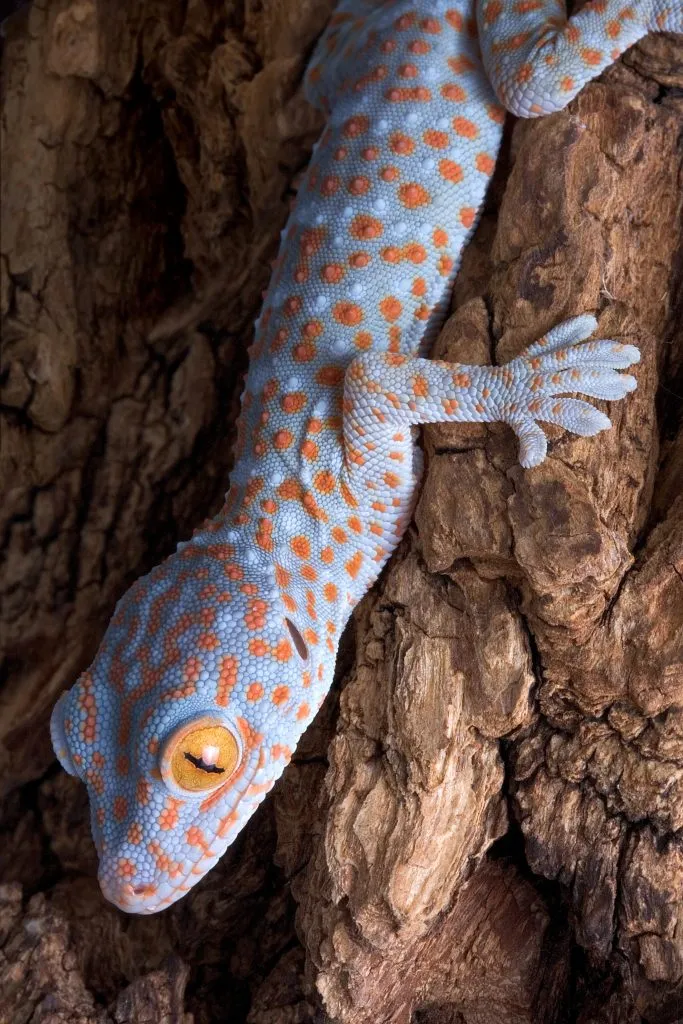
What To Feed
Tokay geckos are insectivorous, meaning they eat mostly insects like crickets, small locusts, moths, mealworms, silkworms, waxworms, grasshoppers, cockroaches, beetles, spiders, and mosquitos.
However, they can also eat other small animals such as mice, rats, and snakes.
Feeder insects should be given a nutritious meal consisting of fresh fruit and vegetables for at least 24 to 48 hours before offering them to the geckos as
How Often To Feed
Baby tokay geckos are voracious feeders and you can feed them pinhead crickets two or three times per day.
Juvenile tokay geckos should be fed once per day, and adults need to eat only once every two or three days.
How Long Can They Go Without Food
Adults can live for up to two weeks without
Do Tokay Geckos Need Water?
In the wild, tokay geckos drink the dew from leaves; therefore, you have to mimic that environment by misting the enclosure regularly.
Tokay geckos need to have water available at all times to avoid dehydration, so make sure to also put a shallow water bowl in the enclosure.
Vitamins And Minerals
You should always dust the feeder insects with calcium powder immediately before giving them to your pet.
Alternatively, you can put a small bowl with calcium carbonate powder in the enclosure and see if your pet ingests it voluntarily. Some tokay geckos actually like eating calcium powder.
Besides this, you should also give a multivitamin supplement to your pet twice per month.
Tokay Gecko Behavior And Temperament
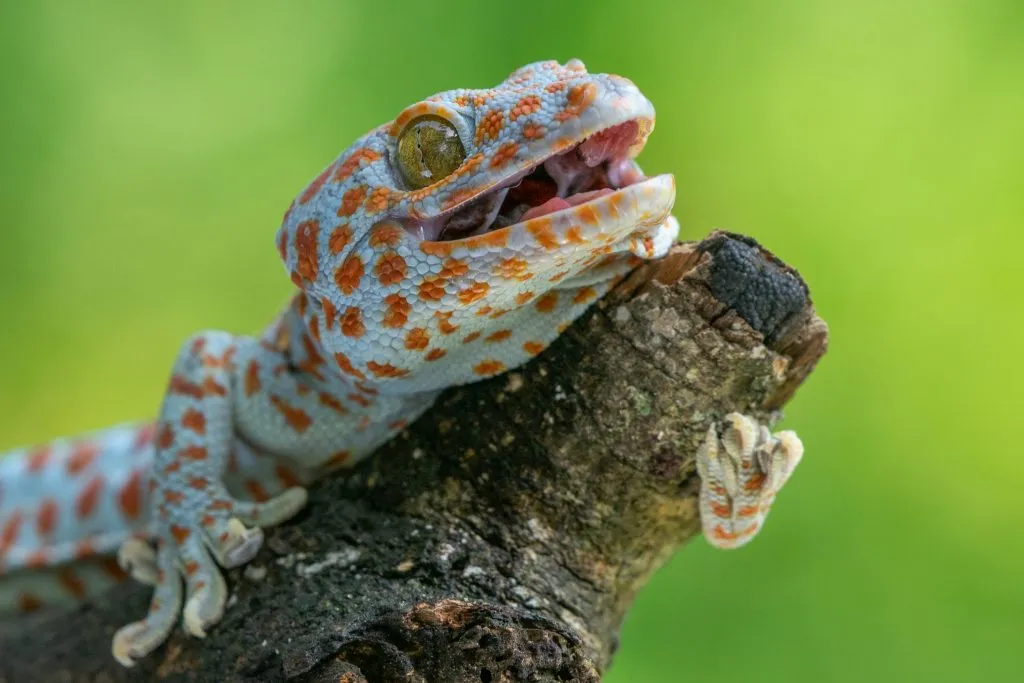
Since tokay geckos are nocturnal it is normal for them to sleep during the day, usually in a head-down position, and become more active during the night.
They are solitary animals and don’t enjoy the presence of other reptiles or animals near them; however, two or more females can live together if the enclosure is big enough. Never put two males together.
Breeding season is usually the only time were a male and female can live together.
Besides this, tokay geckos are known for having a highly aggressive temperament and biting down hard when feeling threatened.
Even though sometimes they can get less aggressive after regular handling, they are still not docile animals.
Are Tokay Geckos Good Pets?
The aggressive temperament of tokay geckos makes them unsuitable for beginners or for households with small children. However, they can be great pets for someone with previous experience handling reptiles.
When grabbing a tokay gecko, make sure to gently place your hand directly behind the animal’s head to avoid being bitten.
Be as careful and gentle as you can when handling your tokay gecko as their skin is very fragile and can tear if you restrain them with too much force. Never grasp them by the tail.
If you get bitten, never pull or tug your tokay gecko to set yourself free as this will cause them to clamp down even harder. Instead, gently place your pet on an even surface near a hiding spot and wait for them to let go.
To avoid injuries for both yourself and your tokay gecko, you can use leather gloves like these or even a small towel when handling your pet.
Tokay Gecko Common Health Problems
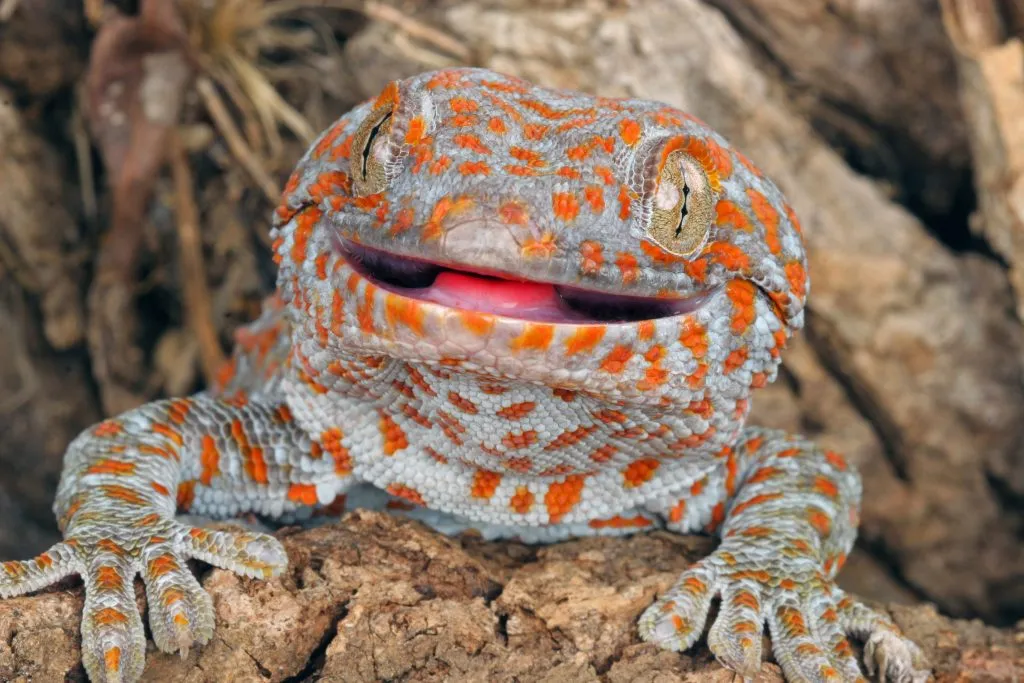
Tokay geckos are susceptible to both internal and external parasitic infections.
Mouth rot or ulcerative stomatitis is another common health problem that can affect your tokay gecko.
Symptoms include a reddish color around your pet’s mouth, blackened teeth, swelling of the mouth cavities, and/or yellow cheese-like discharge.
Where To Buy Tokay Geckos?
If you feel a tockay gecko may be a good pet for you, make sure to get it from a reputable breeder.
Even though these reptiles are very easy to breed in captivity, most specimens offered for sale are caught in the wild.
Therefore, you need to know what to look for when buying a tokay gecko. The animal should be feisty when you try to pick it up and should look robust with no visible rib or pelvic bones.
Check for deformities, bumps, or depressions in the reptile’s body as this can be a sign of fracture or infection.
Tokay Gecko Breeders
You can get tokay geckos from many breeders within the US, some options include:
Tokay Gecko Price
Tokay geckos can be found at a price range of 20$ to 50$.
Tokay Gecko Breeding
Breeding season lasts for about four to six months, usually from late October to early May.
Males repeatedly use a very loud call which sounds like “to-kay” to attract a mate. This sound is the origin of their name.
Mating happens frequently, which allows females to lay eggs several times throughout the breeding season.
Females often prefer to lay their eggs on vertical surfaces and they can even lay them on the
- Eastern Rat Snake: Nature’s Pest Control and Fascinating Reptile - September 20, 2024
- Eastern Racer: The Fast and Agile Snake - September 19, 2024
- The Eastern Indigo Snake: The Majestic, Non-Venomous Hunter of the Southeast - September 18, 2024
